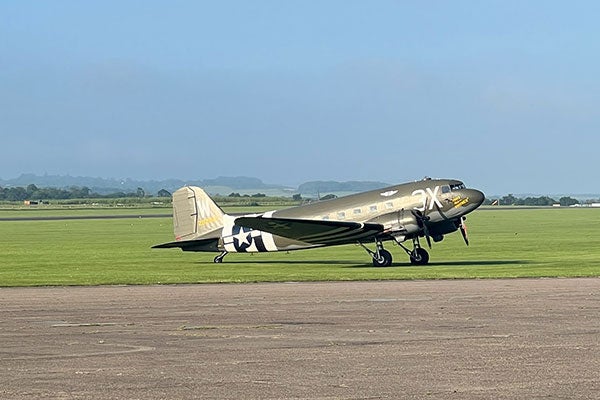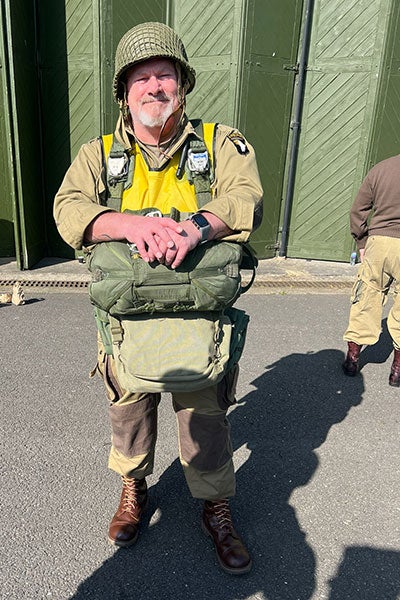D-Day jump gives Brody simulation fellow perspective on training students

Bill Vasios is a simulation fellow at the Brody School of Medicine’s clinical simulation program and an adjunct clinical associate faculty member in the Department of Physician Assistant Studies.
A few years ago, after nearly 40 years of service, Bill Vasios, a simulation fellow at the Brody School of Medicine’s clinical simulation program and an adjunct clinical associate faculty member in the Department of Physician Assistant Studies, retired from the Army. During those many years, he travelled across the globe, from Japan to Iraq.
He’s seen a lot, learned a lot and taught a lot.
But while his time in uniform has concluded, Vasios hasn’t lost his connection to his military past or the people he served with. Before his retirement, Vasios was offered a chance to jump into western France as part of the 75th anniversary of D-Day, the beginning of the liberation of Europe during World War II. He couldn’t make that jump, but when the same offer was extended to be part of the 80th anniversary, Vasios well, jumped at the chance.
“These were original aircraft that did the D-Day jump that had been refurbished at significant expense,” Vasios said. “I probably have over 150 static line jumps and jump master wings, so I have experience, but I just haven’t jumped in a long time.”
The night before the jump, Vasios and his friends visited the Eagle bar in Cambridge, England, to share a beer as their predecessors had 80 years prior, the night before the invasion. Their experiences were different from those that Vasios and the Green Berets had in Iraq and Afghanistan, but a thread of surreality has woven its way across the decades.
“Doing that jump was a good experience because now I’ve walked those same grounds, and I’ve seen some of the same things – obviously nowhere near the same conditions – but I’ve got a pretty good imagination,” Vasios said.
Becoming a soldier
After high school, Vasios joined the Army to train as a telecommunications center operator. During training, he saw a group of soldiers practicing advanced rappelling techniques. Vasios asked his sergeant if he could train to do that and was told the other soldiers were Rangers.
Their training was special.
“When you go to airborne school, just volunteer for the Rangers,” Vasios remembered. “If they need your job, then they’ll pick you up. I kind of forgot that I had volunteered, and they were like, ‘Hey, go over here and do this’, so I spent my first four years in the Army in the 75th Ranger Regiment.”
As often happens with high performers, Vasios looked for the next challenge after several years as a Ranger and was selected to train as a Green Beret – first as a Special Forces engineer sergeant, and then later as a weapons expert.
Throughout his time in uniform, Vasios wanted to be a Special Forces medical sergeant, but it was an uphill fight to be accepted into the long and intensive process.
“Apparently, on paper, I didn’t look like I would be a good medic, but I kept asking, and eventually, they offered me the opportunity,” Vasios said. He went on to become one of a select few Green Beret medics, roundly considered the best in the world at their jobs.
Physician assistant training

The refurbished C-47 airplane that flew during D-Day that Bill Vasios jumped from during a reenactment of the 80th anniversary of the liberation of Europe.
In 2000, Vasios had a decision to make – veer away from his role as a Green Beret medic and take on roles managing soldiers or make a huge leap by leaving active duty and becoming a physician assistant (PA). The decision ended up being simple, Vasios said. He pursued being a PA because he relished the job as a soldier, but that life is often punishing for the family.
“And I decided that my brain would outlast my back,” Vasios said.
He was offered placements in several physician assistant programs, but ultimately accepted a seat in the program at Wake Forest University. Some fellow Special Forces medics were in the class a year ahead of him and told the faculty he would make a perfect fit.
“They never said anything about it to me, but they went to bat for me in an incredible way,” Vasios remembered. “I really enjoyed Wake Forest. It was a great school with a lot of great people.”
During his clinical rotations in the PA program, Vasios wanted as many emergency medicine-related experiences as possible. He felt comfortable with difficult medical challenges and opted for electives in neurology; ear, nose and throat; and orthopedics — all which would benefit him during clinical rotations at Fort Liberty’s Womack Army Medical Center.
“I was already credentialed at Womack, so I was completely at home and comfortable in that environment,” Vasios said. “A lot of the providers in the different residencies knew me, and they were comfortable with me. I couldn’t have done clinical rotations at a better place.”
Vasios said he wasn’t worried about the “snot bubbles and alligator tears” that often show up in any emergency department’s lobby. Neurology problems were a different knot to untangle, though.
“Concussions, strokes, seizures, neurological deficits, paresthesia — that scared me because I didn’t know anything about it, and you thankfully don’t see a whole lot of that on a team,” he said.
The neurologist Vasios completed his rotation with talked him into taking a job with his practice, and at the same time Vasios joined the North Carolina National Guard. The clinical work was fulfilling, but Vasios had a nagging sense that he needed to put his skills to use back in the Army.
Around the time that Special Operations soldiers from Fort Liberty were streaming into Afghanistan and Iraq, Vasios was back at his old unit as the physician assistant, preparing his fellow Green Berets for deployments.
At the time, handheld ultrasounds were being tested for use in combat situations and Vasios knew that he could be the right person to help teach those medics how to use them.
“You have to design the training to their environment and put it in a language that makes sense to them and apply to their scope of practice,” Vasios said.
He continued to serve until 2019, deploying to war zones and across Africa.
Transition to teaching

Bill Vasios wears a replica WWII paratrooper uniform during his jump into France during the 80th anniversary of D-Day.
Vasios now works at Brody as part of a two-year fellowship that is helping him train ECU’s medical, PA and nursing students as part of dissertation work for a doctoral degree in education with a concentration in instructional design and technology he is pursuing through Liberty University.
The students that Vasios now helps train at Brody’s Clinical Simulation Center are not dissimilar to the Special Forces medics from his previous life. Both prepare themselves to save lives, and all are incredibly smart and driven. What they most need prior to stepping into their jobs is an opportunity to succeed and fail in training without the repercussions of a live person on the other end of the stethoscope.
“The checklist for a procedure says you do it 1-2-3-4. OK, you got that down, and now that you understand the process, how can you combine steps two and four,” Vasios explained. “Things are likely going to fail at some point. When you are comfortable with the normal process, complications and equipment failure will happen, so you should not be surprised when it does. You should be expecting it and already have a backup plan.”
Vasios believes one of the greatest skills he brings to teaching ECU students is calmness that comes from the experience of having to block out life and death distractions to focus on the task at hand. He hopes that he can impart that clearheaded thinking to his students through repetition – and success and failure – in simulation spaces.
“You don’t want to learn the adverse effects of something with a real patient,” Vasios said. “The benefit of simulation is that you can make all your mistakes, and nobody is harmed.”
The students Vasios trains at Brody are temperamentally similar to the medics he served with in uniform – the majority recognize that they know what they don’t know and are motivated to fill in the gaps.
“They’re like brand new sponges — like they want to learn everything,” Vasios said.
The perspective he has gained through living a soldier’s life is translating into his stewardship of the students who pass through the Brody simulation center.
“If they have a bad day or a tough rotation, I can ask them, ‘Have you taken care of a patient like this before? How’d that work out? What were your issues? What were you thinking?’” Vasios said. “I think what I can bring to this simulated environment. It can be very surreal. You don’t want to make it too real when you’re doing this training, but you want to make it realistic, so they have a learning experience in that moment.”
MORE BLOGS